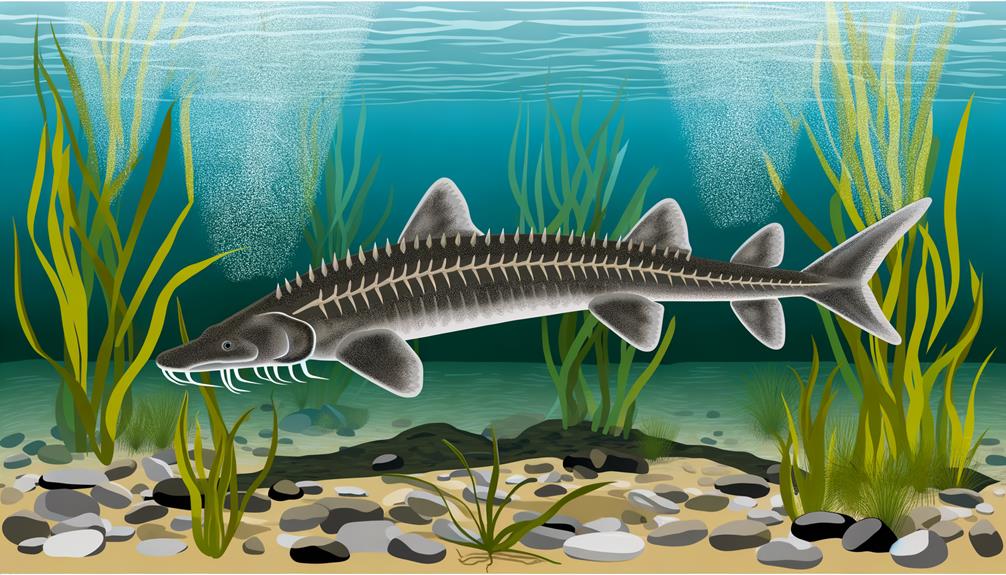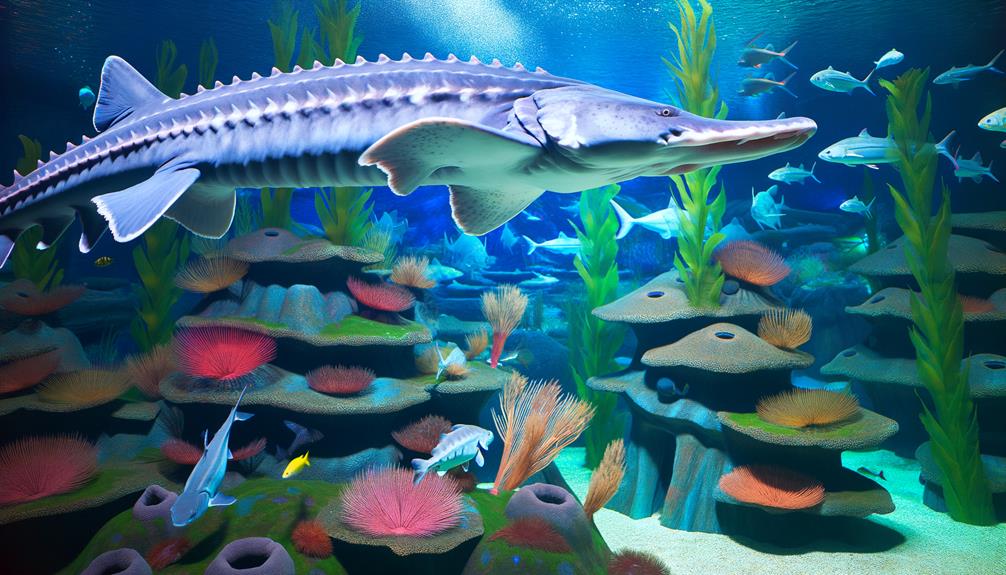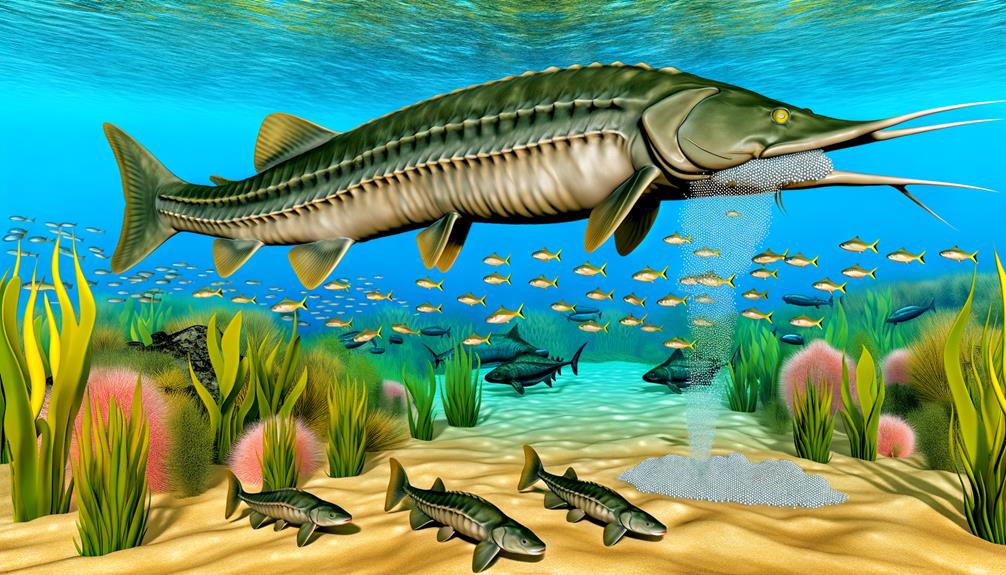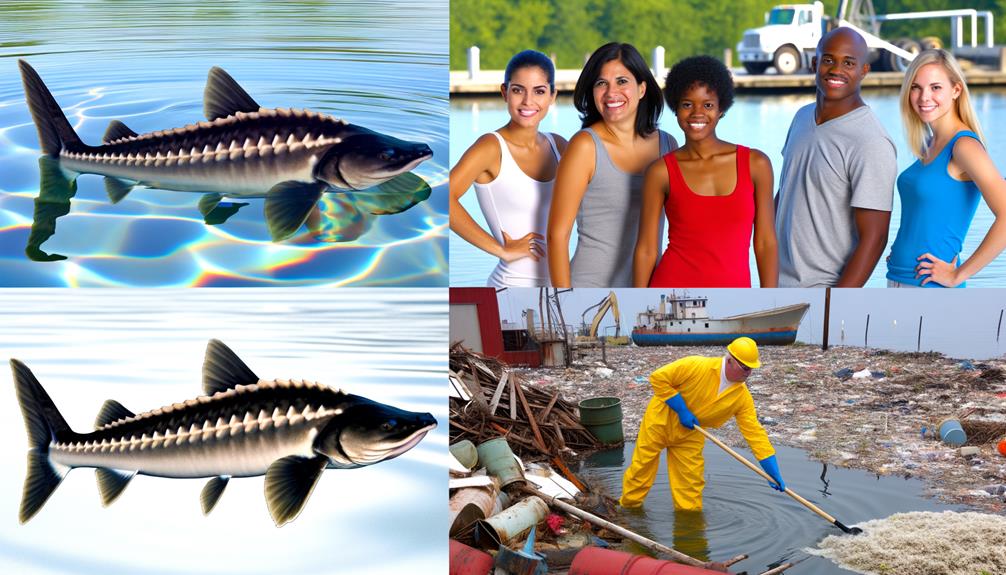The classification of sturgeon as either saltwater or freshwater fish has always been a topic of intrigue among ichthyologists. Although sturgeons are generally found in freshwater habitats, some species exhibit fascinating adaptability to brackish and coastal marine environments.
This adaptability raises the question: Should sturgeons be considered saltwater fish? The answer is not as straightforward as one might think, leading us into a captivating exploration of the diverse life history strategies, ecological preferences, and evolutionary patterns of these remarkable creatures.
Key Takeaways
- Sturgeons are adaptable creatures that can thrive in both freshwater and saltwater environments.
- They migrate from saltwater habitats to freshwater rivers for spawning, exhibiting anadromous behavior.
- Coastal areas and estuaries are crucial transition zones for sturgeons, allowing them to acclimatize to different water conditions.
- Despite primarily exploring larger saltwater habitats for food, the spawning of sturgeons occurs exclusively in freshwater rivers.
Understanding Sturgeon Species
When it comes to understanding sturgeon species, it's essential to note that these fascinating creatures are primarily freshwater fish, with certain species demonstrating a remarkable tolerance for brackish water. Species like the Atlantic sturgeon and Gulf sturgeon exemplify this resilience, thriving in both freshwater and saltwater environments.
Their ability to inhabit diverse habitats is rooted in their anadromous behavior, which involves migrating between marine and freshwater environments for spawning. This migration is a vital aspect of their lifecycle, contributing significantly to the continual propagation of sturgeon populations.
Understanding the habitats of sturgeon species also requires an appreciation of the varying salinity levels they can withstand. While sturgeons are primarily associated with freshwater rivers, they can, and often do, inhabit coastal waters where salinity levels fluctuate. This ability to adapt to such varying environments further underlines their remarkable resilience and ecological versatility.
This insight into sturgeon species paints a picture of a resilient group of fish, expertly adapting to survive in different environments. Recognizing this adaptability highlights the significance of maintaining the diverse habitats crucial for their survival, thereby assisting in the conservation of these remarkable creatures.
Evolution and Fossil History
Sturgeons, with their existence tracing back to between 174 and 201 million years ago, are renowned for their evolutionary stability and minimal morphological changes, thus earning them the moniker of 'living fossils'.
Their fossil records, dating from the late Triassic period, attest to their survival through the Great Permian Extinction and beyond.
Current scientific efforts are focusing on resolving taxonomic ambiguity among sturgeon species, utilizing systematic data and molecular techniques to refine classifications.
Sturgeon's Evolutionary Journey
Despite their ancient lineage dating back over 174 to 201 million years, sturgeons have undergone minimal morphological changes, thus earning the moniker of living fossils. Their evolution has been marked by resilience, adapting to freshwater environments amidst habitat destruction and pollution.
Sturgeons' classification, however, presents a scientific conundrum due to considerable individual variation, leading to taxonomic confusion. Over 40 proposed species were later rejected, underlining the complexity of their classification. To resolve this, researchers are employing systematic data analysis and molecular techniques.
Despite facing threats such as overfishing and habitat destruction, these formidable fish have exhibited remarkable resilience, reinforcing their reputation as survivors from a bygone era. Their enduring presence is a stark reminder of the inextricable connection between evolution, adaptation, and survival.
Fossil Records Explored
How has the ancient lineage of sturgeons, as evidenced by their fossil records dating back to the late Triassic period, influenced their evolution and adaptation over millions of years? Despite enduring major extinction events like the Permian Extinction, sturgeons have remained part of the actinopterygian fishes' ancient lineage with minimal evolutionary changes. Their primitive traits, retained from the Late Cretaceous period, demonstrate a remarkable testament to their adaptation abilities.
| Time Period | Evolutionary Changes | Significant Events |
|---|---|---|
| Triassic period | Fossil record begins | Ancient lineage |
| Late Cretaceous | Minimal changes | Primitive traits |
| Permian Extinction | Survival | Major extinction |
This detailed analysis of sturgeon's fossil record provides valuable insights into their resilience and evolutionary journey.
Physical Characteristics of Sturgeons

Sturgeons, recognized for their unique physical attributes, possess an elongated body structure, partly covered by bony plates known as scutes, which contribute to their distinctive appearance.
Their scaleless skin, coupled with particular sensory barbels surrounding their mouth, proposes an intriguing field of study regarding their adaptive capabilities.
Additionally, their size range is noteworthy, as certain species are among the largest freshwater fish.
Sturgeons' Distinct Body Structure
The distinct body structure of sturgeons, marked by an elongated, spindle-like form and smooth, scaleless skin, sets them apart in the aquatic world. Their bodies, armored with five lateral rows of bony plates known as scutes, reflect the robustness of these ancient creatures.
Sturgeons possess several unique features:
- Their jaw suspension allows for toothless, giant mouths, equipped with sensitive barbels, aiding in their feeding process.
- The presence of sensory organs, an evolutionary adaptation for survival.
- A heterocercal tail, a primitive characteristic, enhancing their swimming ability.
- The elongated body shape, contributing to their distinct appearance.
- The scaleless armor, a testament to their resilience.
These physical attributes make sturgeons one of the most fascinating species among aquatic life forms.
Unique Skin and Scales
Building upon their distinctive body structure, the smooth, scaleless skin of sturgeons, adorned with five lateral rows of bony plates known as scutes, further underscores their unique physical characteristics. These scutes, composed of a bone-like material, provide protection and lend the fish an ancient, armored appearance, suggestive of their primitive origins.
The scutes serve as a formidable form of armor, crucial for sturgeons' survival in diverse aquatic habitats. The presence of these bony plates also aids in navigating their benthic environments, a testament to the adaptability of this ancient species.
Indeed, the unique combination of skin and scales typifies sturgeons, contributing to their extraordinary resilience and survival across the epochs, and offers a tangible link to our planet's distant, aquatic past.
Sturgeons' Notable Size Range
In terms of sheer physical presence, few aquatic creatures can match the remarkable size range of sturgeons, with some species reaching lengths of up to 25 feet and weights averaging around 200 pounds. These Atlantic fish are known for their massive size and elongated bodies, covered in bony plates, or scutes, providing a robust physical armor.
- Sturgeons, with their toothless mouths and sensitive barbels, exhibit unique feeding characteristics, setting them apart in aquatic ecosystems.
- Their remarkable size underscores the significance of these creatures in their habitats.
- The unique scutes covering their bodies serve as a vital protective attribute.
- Their elongated body shape is another distinguishing feature enhancing their survival ability.
- Sturgeon's massive size and unique physical traits contribute to their status as one of the most remarkable creatures in marine settings.
Sturgeon Habitats Explored

Primarily residing in freshwater rivers and venturing into coastal waters near river mouths, sturgeons exhibit a fascinating dual habitat lifestyle that's pivotal for their lifecycle. As anadromous fish, sturgeons demonstrate a complex pattern of migration between freshwater and saltwater habitats. This migration is central to their survival and reproduction.
Coastal areas, specifically those featuring estuaries, provide essential transition zones for these fish. Estuaries function as ecological crossroads, where freshwater from rivers meets the saltwater of the sea. For sturgeons, these habitats serve as gateways, allowing them to acclimatize to the contrasting water conditions.
Beyond estuaries, sturgeons venture into larger saltwater habitats such as bays and open ocean areas. These environments offer abundant food resources, facilitating the growth of these fish before they embark on their return journey to freshwater territories. The spawning phase of their lifecycle occurs exclusively in freshwater rivers, making their habitat selection a biological necessity.
Predators and Prey Dynamics
While understanding the habitat preferences of sturgeons is crucial, it's equally important to examine the dynamics of their predators and prey, especially given their unique feeding behaviors and the threats they face in both saltwater and freshwater environments. The Atlantic sturgeon, like most sturgeons, are bottom feeders, relying on various sensors for opportunistic feeding on invertebrates and other prey.
Sturgeons employ a sophisticated array of sensory systems to detect and capture prey, including:
- Olfactory sensors: Sturgeons have a keen sense of smell to locate food sources.
- Tactile cues: They use their barbels (whisker-like appendages) to feel their surroundings and find prey.
- Chemosensory cues: These allow sturgeons to detect chemical changes in the water, signaling the presence of potential prey.
- Predation threats: Sturgeons face predation from larger marine organisms like sharks in saltwater environments.
- Prey dynamics: The availability and types of prey in their habitat significantly influence sturgeons' feeding behavior.
These complex interactions between sturgeons and their environment underscore the intricate balance of predator-prey dynamics in both freshwater and saltwater ecosystems where sturgeons reside, demonstrating their adaptability and resilience in the face of challenges.
Sturgeon Reproduction and Lifespan

Remarkably, sturgeons are known for their exceptional reproductive strategy and considerable lifespan, factors that play a significant role in their survival and adaptability. As broadcast spawners, female sturgeons release thousands to millions of adhesive eggs into the water, which then undergo external fertilization. This unique method of reproduction results in a large number of larvae, which rely on river currents to transport them to suitable habitats for their growth and development.
Sturgeons, being long-lived species, can reach the impressive age of up to 100 years, with an average lifespan spanning 50 to 60 years. A significant number exhibit anadromous behavior, migrating from the sea to freshwater environments to spawn. This migratory pattern is critical in ensuring reproductive success and species continuity.
However, these fish face significant threats, notably overfishing and habitat degradation. Overfishing reduces the number of mature individuals that can reproduce, while habitat degradation can disrupt their anadromous behavior, impede the river currents needed for larvae dispersion, and make suitable habitats harder to find. This has significantly impacted their populations and poses a threat to their survival.
Impact of Human Interactions
Human interactions, particularly overfishing and habitat destruction, have significantly contributed to the decline of sturgeon populations in their primary saltwater habitats. Overfishing has resulted from both commercial and local fishing practices that have outpaced the sturgeon's slow reproduction and maturation rates. Habitat destruction, on the other hand, has been largely driven by human-induced environmental changes and physical alterations of the sturgeons' saltwater habitats.
Several factors have exacerbated this situation:
- Industrial runoff and pollution: These byproducts of human activities often contain harmful substances that degrade the quality of sturgeon habitats.
- Agricultural practices: The use of pesticides and fertilizers can result in harmful runoff that enters sturgeon habitats, causing detrimental effects.
- Shipping: This activity often leads to noise and water pollution, which can disrupt sturgeon behaviors and habitats.
- Dredging: This can destroy the sturgeons' breeding and feeding grounds, leading to population decline.
- Inadequate fisheries management: Without proper management and conservation efforts, the negative impacts of these human activities on sturgeon populations may continue unabated.
Conservation Efforts and Challenges

In light of the escalating threats to sturgeon populations, a multifaceted approach to conservation has been necessitated, grappling with issues like overfishing, habitat destruction, pollution, illegal trade, inadequate enforcement of regulations, and the need for international cooperation. As a keystone species, sturgeon survival is indicative of the overall health of their ecosystems, making their conservation crucial for preserving aquatic biodiversity.
Organizations such as the National Oceanic and Atmospheric Administration (NOAA), International Union for Conservation of Nature (IUCN), and Convention on International Trade in Endangered Species (CITES) are instrumental in sturgeon conservation. They implement measures that balance sustainable harvest with population recovery goals, while combating illegal trade.
The following table summarizes the challenges and conservation efforts:
| Challenge | Conservation Effort |
|---|---|
| Overfishing | Regulation Enforcement |
| Habitat Destruction | Habitat Restoration and Protection |
| Pollution | Pollution Control Measures |
| Illegal Trade | International Cooperation |
The Truth: Saltwater or Freshwater?
Despite their frequent presence in saltwater environments for feeding and growth, sturgeons are predominantly freshwater fish, possessing a unique ability to adapt to changing salinity levels throughout their life cycle. This adaptation allows them to traverse between freshwater rivers and the saline ocean, a behavior known as anadromous migration.
To further clarify this complex life cycle and habitat preference, consider the following facts:
- Sturgeons spawn in freshwater environments, specifically rivers, marking the beginning of their life cycle.
- They mature and grow in brackish habitats, where freshwater and saltwater mix, often in estuaries.
- Upon reaching adulthood, sturgeons, especially species like the Atlantic sturgeon, migrate to saltwater environments for feeding.
- Despite spending considerable time in saltwater environments, they return to freshwater for spawning.
- The ability to adapt to varying salinity levels is a key survival trait of sturgeons.
As such, while sturgeons can be found in both freshwater and saltwater environments, they are fundamentally freshwater fish. Understanding this fact is crucial, not only for scientific knowledge but also for promoting conservation efforts tailored to their unique life cycle and habitat preferences.
Frequently Asked Questions
Can Sturgeon Be in Salt Water?
Yes, sturgeon can inhabit saltwater. Their migration patterns involve movement between salt and freshwater environments, demonstrating remarkable adaptation. However, breeding typically occurs in freshwater, emphasizing the need for diverse habitat preservation in sturgeon conservation efforts.
Is Sturgeon a Freshwater or Sea?
Sturgeons are anadromous fish, spending portions of their lifecycle in both freshwater and marine habitats. Their unique behavior contributes to their diverse diet, reproduction, size, and anatomy, yet also exposes them to a variety of threats.
Is White Sturgeon a Saltwater Fish?
White sturgeons primarily inhabit freshwater environments like rivers and estuaries. Although they can tolerate some salinity and occasionally venture into brackish or saltier waters, they are not classified as true saltwater fish.
Why Can't You Eat Sturgeon?
Sturgeon are not commonly consumed due to their endangered status, heightened by factors like overfishing, habitat destruction, and industrial pollution. Their slow reproduction rate and high demand for caviar intensify these conservation and toxicity concerns.
Conclusion
In conclusion, while sturgeons can survive in brackish water and even venture into coastal marine environments, they predominantly inhabit freshwater ecosystems, defying the common misperception that they are saltwater fish.
Their survival, reproduction, and dietary habits are intricately tied to freshwater habitats. Therefore, despite their extraordinary adaptability, likening sturgeons to saltwater fish would be nothing short of a gross exaggeration of their ecological traits.


